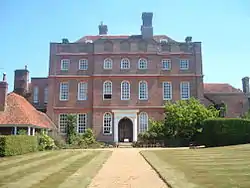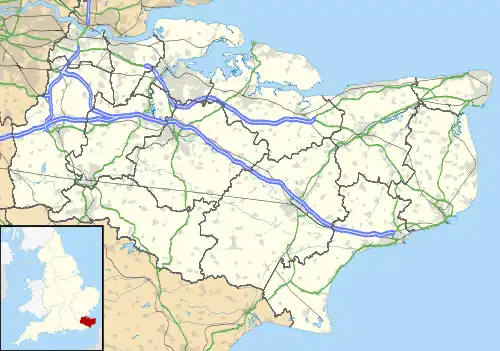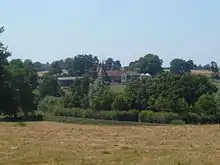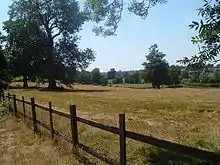| Finchcocks | |
|---|---|
 View of the rear of the house, from the garden | |
 Location of Finchcocks in Kent | |
| General information | |
| Type | House |
| Architectural style | Georgian |
| Classification | Grade I listed |
| Address | Finchcocks |
| Town or city | Goudhurst, Kent |
| Country | United Kingdom |
| Coordinates | 51°06′08″N 0°25′38″E / 51.1022°N 0.4273°E |
| Completed | 1725 |
| Technical details | |
| Floor area | 15,387 square feet (1,429.5 m2) |
Listed Building – Grade I | |
| Designated | 9 June 1952 |
| Reference no. | 1318935 |
| TQ 7003 3646 | |
Finchcocks is an early Georgian manor house in Goudhurst, Kent. For 45 years it housed a large, visitor-friendly museum of historical keyboard instruments, displaying a collection of harpsichords, clavichords, fortepianos, square pianos, organs and other musical instruments. The museum was run by the owners of the house, Richard and Katrina Burnett. It is now owned by Neil and Harriet Nichols[1] who use it as a family home and a venue for residential piano courses.
In 2017, the museum was closed and the collection sold.[2]
Ownership
The house was built in 1725 and named after the family who lived on the site in the 13th century. Finchcocks was owned by Edward Horden, who's family crest lies above the front door. Edward was 'Clerk of the Green Cloth' - a secretary to the board that was responsible for organising royal journeys and auditing the Royal Household accounts for three monarchs, Edward VI, Mary and Elizabeth I. The current house was built for Edward Bathurst, a London barrister and 'Master of the Middle Temple'. Edward Bathurst (1680-1772) owned the estate of Finchcocks, and property in Jamaica, where he married his second wife, Mary Gyles. Two years before Edwards death, his son from his second marriage- Charles Bathurst purchased Finchcocks and his Jamaican property from him. This included 56 enslaved people (35 were listed as male and 21 as female. 8 were listed as boys, girls or children) When Charles died in 1767, he bequeathed both Finchcocks and his Jamaican property to his brother Rev. Richard Bathurst. In 1768, during abolition, a claim was made for £2675 as compensation for the Bathursts' 56 enslaved people in Jamaica. [ </nowiki>https://www.ucl.ac.uk/lbs/person/view/2146660691]. Richard Bathurst sold Finchcocks in 1796, and died in 1803. His will makes no mention of Jamaican property. [ https://www.ucl.ac.uk/lbs/person/view/2146660691 ]An online unsourced blog states that Richard's eldest son Edward (bap. 1774) was a friend of the Prince Regent and lost his Jamaican estate to gambling debts. Finchcocks was sold to Robert Springett c.1796-97, alegedly to pay for gambling debts.
Sir James Stirling lived at Finchcocks in the early 1900s and described the house in his memoirs The Weald of Youth (1942).
During the Second World War pupils and teachers from Kings School Rochester lodged there before the house was requisitioned by the army.
In the 1960s it was a school for The Legat Ballet - Nicolas Legat and his wife Nadine Nicolava Legat, who brought the classical Russian style of ballet to the UK back in 1923.
Since 1971 it has been owned by international concert pianist Richard Burnett and his wife Katrina and opened to the public in 1976 as the renowned Finchcocks Musical Museum.
After wartime use for military purposes and a period of institutional use in the 1960s, the house was acquired in 1971 by Richard and Katrina Burnett, who restored it and in 1976 opened it as both a museum housing their collection of historic keyboard instruments and a centre for concerts and other musical events. When they decided to retire and downsize in 2015, much of the important collection was dispersed at auction, but Finchcocks itself was sold to another musical couple, Neil and Harriet Nichols, who run courses for pianists at the house, as well as making it their home.
Architecture
It is noted for its brickwork and has a dramatic front elevation attributed to Thomas Archer. It is located in 13 acres (5.3 ha) of grounds. There is parkland to the front and a garden to the rear with wide lawns, mature shrub borders, an orchard for wild flowers, and a walled garden. There are extensive views over the Kentish landscape of park, farmland, and hop-gardens.
The house, with impressive facades both back and front, is deceptive – the interior is a series of interconnecting rooms without corridors and only 13 metres deep.[3] Those rooms, with their high ceilings and oak panelling, provided an ideal setting for music performed on period instruments; the house and instruments were used regularly for recordings by leading exponents of early music such as Trevor Pinnock, Simon Preston and Nigel North. In addition to that, there is a jazz club which was founded by Alastair Laurence of the Broadwood Piano company and was developed by Roan Kearsey-Lawson into a premier jazz venue where international artists have appeared including Frank Holder and Duncan Lamont. The club has also been featured on BBC One television.
The Finchcocks collection
Finchcocks was acquired by Richard Burnett, a fortepianist, in 1970. The Adlam Burnett workshop (founded by Derek Adlam and Richard Burnett) was set up at the house and enabled instrument makers to produce copies of historical keyboard instruments in an ideal environment, learning from the construction of many originals. The building housed the Katrina and Richard Burnett collection of over 100 historical keyboard instruments; about forty of which were fully restored to playing condition. These could be seen and heard whenever the house was open to the public; it was one of the few collections of historical instruments at which people were welcome to play them themselves. With the Burnetts' retirement in 2015, the museum closed and many of its instruments were auctioned off for charity.[4] The auction catalogue[5] documented the instruments meticulously and in the auction many fetched two or three times the estimated prices. A total of £835,462 was raised from the sale of the collection.[6]
Fourteen instruments from the collection were retained and form the Richard Burnett Heritage Collection, to be housed in 2018 at the Burnetts' home in Tunbridge Wells.[3][7]
Similarly, there is a collection of musical pictures, prints and an exhibition on the theme of London's 18th-century pleasure gardens such as Vauxhall and Ranelagh Gardens.
Historical instruments in the collection

Clavichords
- Lindholm and Söderström: unfretted, 1806
- Georg Friedrich Schmahl: fretted, 1807
Harpsichords
- Joachim Antunes: single manual, 1785
- Thomas Blasser: double manual, 1744
- C.A.: bentside spinet, c.1700
- Fr. Ant. L.: single manual, 1716
- Gregori: single manual, c.1697
- Onofrio Guarracino: virginal, 1668
- Jacob Kirckman: double manual, 1756
- Joseph Mahoon: bentside spinet, 1742 (today in Geelvinck Early Piano Museum, Amsterdam, Netherlands)
Organs
- Anon: chamber organ, c.1680; chamber organ, c.1790; miniature free-reed organ, c.1860
- Alexandre Père et Fils: harmonium, 1859
- Autophone Company: cob organ (portable free-reed barrel organ), c.1885
- John Avery: chamber organ, 1792
- William Ayton: barrel organ, c.1800
- John Byfield: chamber organ, 1766
- Longman and Broderip: barrel organ, c.1790
Pianos
- Anon: portable square piano, c.1815; lyre piano (possibly Schleip, Berlin), c.1825; domestic barrel piano, 19th century
- Gustaf and Wilhelm Andersson: barrel piano, c.1890
- Bayes and Company: square piano, 1793
- Frederick Beale: upright euphonicon, c.1842
- Adam Beyer: square piano, 1777
- John Brinsmead and Sons: upright, c.1855
- John Broadwood and Son: grand, 1792; square, 1795; square, 1798; grand, 1801; square, c.1805
- John Broadwood and Sons: grand, c.1810; square, c.1820; grand, 1823; cabinet upright, c.1830; grand, 1846; square, 1858; grand, 1859 (now at Hammerwood Park, East Grinstead, Sussex); upright, c.1870
- Muzio Clementi and Company: grand, c.1800; upright grand, 1804; square, c.1815; square, c.1815; square, c.1815; grand, c.1815; grand, c.1821; grand, 1822; cabinet upright, c.1825; cabinet upright, c.1825
- Collard and Collard: square, c.1835; grand, c.1835; grand, c.1840
- William Edwards: cabinet upright, c.1825
 Another view from Finchcocks
Another view from Finchcocks - W.J. Ennever and Son: upright, c.1850
- Sébastien Érard: square, 1792
- Erard Frères: grand, 1801
- Erard: upright, c.1860; grand, 1866
- Johann Fritz: grand, c.1815
- Christopher Ganer: square, c.1780; square, 1784
- Conrad Graf: grand, c.1820; grand, 1826
- Crang Hancock: transverse grand, 1779
- Carl Henschker: grand, c.1840
- Mathias Jakesch: grand, 1832
- Jones, Round and Company: upright grand, c.1810 (today in Geelvinck Early Piano Museum, Amsterdam, Netherlands and on loan at Huis Midwoud, Midwoud)
- William Kearsing: square, c.1830
- Knowles and Allen: square, c.1805
- Sebastian Lengerer: grand, 1793
- Longman, Lukey and Company: square, c.1780
- Frederick Mathuschek: square, 1873
- Sébastien Mercier: upright, 1831
- Henri Pape: upright piano-console, 1841; upright piano-console, 1843
- Ignace Pleyel et Compagnie: upright, c.1840; grand, 1842
- Michael Rosenberger: grand, c.1800
- Leopold Sauer: pyramid piano, c.1805
- William Southwell: upright square, c.1800
- Robert Stodart: grand, 1787
- William and Matthew Stodart: grand, 1802 (now at Hammerwood Park, East Grinstead, Sussex); square, 1807
- Johann Baptist Streicher: grand, 1867 (today in Geelvinck Early Piano Museum, Amsterdam, Netherlands)
- Anton Walter und Sohn: square, c.1800
- Wilson: square, 1789
- Robert Woffington: upright, c.1800 (today in Geelvinck Early Piano Museum, Amsterdam, Netherlands)
- Johannes Zumpe and Gabriel Buntebart: square, 1769 (today in Geelvinck Early Piano Museum, Amsterdam, Netherlands)
Others
- Anon: cylinder musical box with drum and bells, c.1895
- Busson: piano accordion, c.1850
- Chappell and Company: keyboard crystallophone (or 'pianino'), c.1815 (today in Geelvinck Music Museum, Zutphen, Netherlands); digitorium, c.1870
- Paul Lochmann: symphonion (disc musical box), c.1895
- Thomas Machell and Sons: dulcitone, c.1920 (today in Geelvinck Music Museum, Zutphen, Netherlands)
- J Tait: angelica (musical glasses), c.1815
Related publications
- Burnett, R: English Pianos at Finchcocks, Early Music (1985)
- Burnett, K and R: Finchcocks Past & Present (2003)
- Dow, W: Finchcocks Collection, Catalogue: the Richard Burnett Collection of Historical Keyboard *Instruments (1989)
See also
References
- ↑ "Goudhurst Parish Magazine" (PDF). Goudhurst and Kilndown Church. December 2016.
- ↑ Independent, The glorious life and times of Finchcocks – the living museum of music, 28 October 2018
- 1 2 Machin, Julian (28 October 2017). "The glorious life and times of Finchcocks – the living museum of music". The Independent. London. Retrieved 5 February 2018.
- ↑ "Finchcocks Musical Museum in Goudhurst set to close its doors". Archived from the original on 22 November 2015. Retrieved 24 February 2016.
- ↑ "Drewaetts Catalogue: The Richard Burnett Collection" (PDF). Retrieved 13 May 2016.
- ↑ "Richard Burnett keyboard collection sells for £835k at auction". BBC News Online. 12 May 2016. Retrieved 16 May 2016.
- ↑ "What's New". Richard Burnett Heritage Collection. Retrieved 5 February 2018.